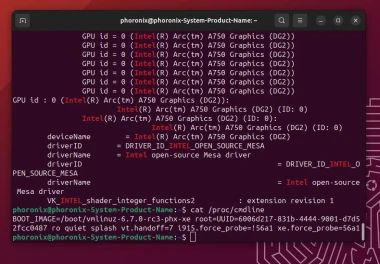Linux 6.8 To Introduce New Intel Xe & PowerVR Graphics Drivers, Prepare For New AMD & Intel CPUs
Linux 6.7 should be released later today as the first stable kernel of 2024. In turn the Linux 6.8 merge window will then open tomorrow and run for the next two weeks. For those curious about the features expected for Linux 6.8, here’s an early look at some of the changes expected to land for that next kernel cycle.
Based on my tracking of the various mailing lists and “-next” Git branches, below is a look at some of the exciting features expected for Linux 6.8. Due to last minute bugs or possible objections from Linus Torvalds, there is the possibility some of the code may be rejected but overall it’s an early look at what’s to find with Linux 6.8. Following the Linux 6.8 merge window and around eight weeks worth of release candidates, Linux 6.8 should debut as stable in March.
From the new Intel Xe kernel graphics driver, the long-awaited Imagination PowerVR Rogue graphics driver, preparing for new Intel and AMD platforms, a few ARM-based handheld game consoles being supported, and more, Linux 6.8 is looking quite exciting.
- The first Rust-written PHY network driver is set to land.
- The Imagination PowerVR open-source GPU kernel graphics driver is finally being upstreamed that can work alongside their PowerVR Vulkan Mesa driver for supporting select Rogue GPUs initially.
- Disabled-by-default AMD color management code is to finally premiere in working towards upstream support thanks to AMD, Igalia, and Valve.
- Mainline kernel support for several cheap ARM-based Linux handheld game consoles that to this point relied on out-of-tree patches.
- The Intel Xe DRM driver is being mainlined in experimental form as an alternative to the i915 DRM driver. The Xe driver is in experimental form and not yet used by default for any current Intel graphics hardware.
- Google Tensor GS101 SoC and Pixel 6 support at long last.
- The Intel IAA crypto compression driver is being merged as an exciting milestone.
- Intel Arrow Lake sound support.
- Intel Lunar Lake Thunderbolt support.
- Intel FDINFO memory statistics and other enhancements to the i915 kernel driver.
- Dropping support for very old graphics drivers.
- Raspberry Pi 5 kernel graphics driver support is tacked onto the V3D DRM driver.
- Atomic mode-setting mouse hotspots and atomic async page flip support.
- Dropping Intel Carillo Ranch support for that hardware that was supposed to ship a decade and a half ago but never did.
- Intel Idle driver support for Sierra Forest and Grand Ridge processors.
- Support for next-gen Intel QAT accelerators that support more engines and more algorithms.
- AMD has a nice performance optimization for their processors.
- AMD WBRF support for mitigating WiFi radio interference.
- More AMD code for the Instinct MI300 series and RDNA3 refresh hardware.
- Support for the AMD MicroBlaze V soft-core RISC-V CPU.
- Continued preparations around AMD Zen 5.
- The AMD AXI 1-wire host driver is being merged.
- The AMD Address Translation Library (ATL) is being introduced to help code sharing moving forward.
- Removing the old ARM11 MPCore CPU support.
- Qualcomm Snapdragon 8 Gen 3 can boot the mainline kernel.
- LoongArch KVM support for the LSX/LASX SIMD instructions.
- Intel LAM for KVM to support Linear Address Masking within virtualized guests.
- The ability to block writes to mounted block devices.
- Removing SLAB while optimizing SLUB.
- SPI NOR multi-die erase support.
- More CXL code is to land for the Compute Express Link subsystem.
- A new driver for Gigabyte Waterforce AIO coolers for hardware monitoring the all-in-one liquid coolers.
- Better communicate when x86 32-bit support is disabled for user-space programs and x86 syscalls.
- The AWS Nitro Secure Module driver is being upstreamed.
- Updating the Zstd code within the kernel for better compression performance.
Stay tuned to Phoronix for my coverage of the Linux 6.8 merge window followed by Linux 6.8 kernel benchmarks.

Add comment